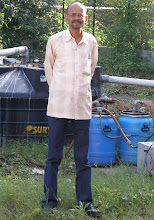Deepak Kanhere
ABSTRACT
When agriculture waste is decomposed, the important gases are vaporized & get wasted. In this article, we will see hoe biogas can be produced by anaerobic digestion of various agri. wastes such as sugar factory effluent, distillery’s spent-west, sugar beet, sweet-sorghum etc. Not only will methane be used for electricity generation but Carbon Dioxide can be used in Agriculture for enhancing production.
In the year 2010-11, there was a bumper yield of sugarcane because of better rains in the monsoon. Higher sugarcane production resulted in an additional production of sugar in all the sugar industries. Due to this, huge molasses was generated. Today almost all the sugar industries dispose the molasses through their distillery units to produce alcohol.
Since the distillery units have produced additional quantity of alcohol, still the question of disposal of spent wash remains unanswered. We at Shashwat Oorja not only believe into eco-friendly and sustainable options but also we behave.
For the disposal of spent wash the process of Anaerobic Digestion (A.D.) is preferred and adopted by sugar industries through co-generation plants on mega watt scale where Biogas is combusted in the generators. We carried some different experiment and found the amazing results.
Though the process of A.D. of spent wash results into good quantity of Biogas while combusting through generators, we adopted the process of enriching Biogas (i.e. separation of Methane). If we analyze the contents of Biogas then….
Methane is 58 - 60%
Carbon dioxide is @ 38 - 40%,
And traces of hydrogen sulphide, ammonia, sulphar dioxide and moister.
To increase the calorific value of Biogas we separated methane from Biogas through a process called water scrubbing. At the same time the high quantity of carbonated water generates. We applied a prototype plant for re-capturing the carbon dioxide from this carbonated water.
Let us understand the weight and volumes of 1 meter cube Biogas.
a) Methane @ around 60% i.e. 600 liters which is 384 gms,
b) Carbon dioxide @ around 40% i.e. 400 liters which is 600 gms, and
C) Traces of hydrogen sulphide, ammonia, sulphar dioxide and moister is around 16
gms by weight.
After the separation of methane and carbon dioxide the calorific value of methane increased in the comparison with normal biogas. But the question of carbon dioxide disposal arose. The technologists are well aware about the usage os carbon dioxide in different industries such as………
a) Porous agent in casting industry
b) An extraction solvent
c) An agent in tigmig welding for non-oxidation
d) Carbonated water in soft drink industry
e) Dry ice for cold chain etc……
These utilities of carbon dioxide in industries are limited as far as the produced quantity of carbon dioxide as a byproduct in other industries is concerned.
We carried out some experiments in different farms for different crops at different seasons in the year.
• At present the available percentage of carbon dioxide in air is @360 - 370 p.p.m. - is
• We increased this percentage by 330 - 340 p.p.m. to reach a maximum level of 700 p.p.m. of carbon dioxide in air.
• This resulted an increase in crop yield from 10 - 18 % depending upon the type of crop of the range C-1, C-2, C-3, & C-4.
• For this we sprayed carbon dioxide in gaseous form approx @ 5 kg per acre.
• The adverse effect was also observed in the case where level of carbon
dioxide went beyond 700 p.p.m., the yield went down.
As everybody knows if the proper quantity of carbon dioxide is offered to the plant the rate of photosynthesis increases and so does the increases in vegetative production which results in high production of food to the leaves.
Another observation of carbon dioxide usage in farm has altogether different perspective. As we sprayed the carbon dioxide in late evenings the entire area nearby to the bottom of crop was highly carbon dioxide enriched and the same helped to get rid of all the insects on the plant by killing them.
At Shashwat Oorja. We believe in innovative experiments and to share our end results with requisite persons by providing the most eco-friendly and sustainable options.

